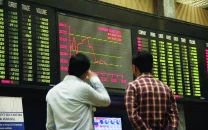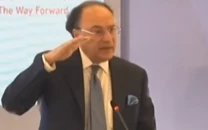Economic crisis in Pakistan and the role of West
IFIs trap and exploit developing countries, but put blame on others

One thing is common among international financial institutions (IFIs), which is they trap and exploit countries, and blame others for their exploitation.
It is an unwritten rule of business and they are applying it with dedication. It is a known fact that many countries crumbled during the reform period under an IMF programme.
Latin American economies are the most cited example, but we can find new ones like that of Hungary and Greece. The two European countries are the most recent examples of the IMF-led disastrous reform recipes.
Hungary started an IMF deal with the implementation of austerity measures, reduction in pension benefits, freezing wages and reducing deficit. It badly struck social welfare spending and systems. People started to agitate against the government, but the IMF was comfortable.
When Hungary’s government tried to create some space for the poor and introduced a banking transaction tax, the IMF reacted very strongly and halted cooperation.
Greece, despite all recipes of the IMF and European institutions and partners, has still been unable to find a sustainable solution.
Pakistan is one of the victims like many other developing countries. It has been entangled in a debt trap. It has started to pay the price in the form of high inflation, free fall of the rupee, shrinking production and elimination of social welfare spending under the dictation of IFIs.
Instead of accepting their mistakes, the IFIs are trying to shift blame on to China. They want to make China a scapegoat for their mistakes.
Opponents of the China-Pakistan relationship and the China-Pakistan Economic Corridor (CPEC) find it as an excellent opportunity to exploit the situation. They have begun smear campaigns and are tagging the bad economic situation of Pakistan with CPEC and Chinese investment.
The statement can be qualified from actions of the US and India as both are fierce opponents of CPEC and the China-Pakistan relationship.
It is an open secret that the US has been pushing Pakistan for a long time to quit CPEC and the BRI. It is part of the US policy to contain China and check its peaceful rise. To achieve the objective, the US is pressurising Pakistan one way or the other.
First, Pakistan was put in the grey list of FATF with the objective of squeezing its economic space. Second, the IFIs are playing their role to pile on pressure. Third, the US has allocated hundreds of millions of dollars to run a campaign against China and CPEC.
Through the COMPETE Act, Washington has reserved $500 million for media to keep a close watch on China and the BRI including CPEC.
On the other hand, India is also trying to step in to sabotage CPEC. It is spreading false rumours about Chinese personnel and its embassy in Pakistan.
An analysis of events in recent decades reveals that the current economic crisis has stemmed from two main factors – IFIs (which have been discussed above) and the war on terror.
The war on terror has undermined Pakistan’s standing in the global arena and its security situation. Although Pakistan did not want to become part of the war, the US and the West forced it to become a frontline ally.
Owing to the war, the country suffered huge losses on all fronts such as the economy, security situation, social sector and human life. It had to bear an economic loss of $150 billion, which is beyond the country’s capacity. It is higher than the current external debt of $130 billion.
On the other hand, Pakistan lost 70,000 precious lives. Hundreds of thousands are still suffering from the psychological effects and many people have become handicapped.
Unfortunately, the allies did not acknowledge the sacrifices of Pakistan. Rather they started erecting hurdles and are even not hesitating to kill economic and development opportunities, like those provided by CPEC, by propagating conspiracy theories and pushing the country into a debt trap.
It is quite unfortunate, but not unexpected. Instead of supporting economic growth and development, they are busy undermining the potential.
CPEC data clearly shows it is helping Pakistan to mitigate problems and is sprouting economic, livelihood and development opportunities. For example, it has helped to create 92,000 direct jobs in the first phase.
Moreover, 100+ small and medium enterprises (SMEs) have benefited from CPEC and created many employment avenues. As a result of the gigantic project, Pakistan has also been able to rein in load-shedding and save $4-5 billion annually.
Contrary to the debt trap conspiracies, data shows that the contribution of CPEC programmes to the national debt is $5.7 billion, which is only 4.5% of the total external debt.
An overwhelming majority of CPEC projects are investment projects. Moreover, the debt under CPEC is productive in nature. It means it is generating economic activities and livelihood opportunities.
On the other side, the debt outside of CPEC stands at around $24 billion. A major chunk of it is in the form of currency swap or deposits to shore up the foreign currency reserves of Pakistan.
Apart from that, China has provided debt to Pakistan in a dire situation, when the allies and IFIs had abandoned it
IFIs, the US and the West may not change their mindset and practices and they believe they have the right to say whatever they want. So, Pakistan and China should establish mechanisms to counter such campaigns and allegations.
To achieve the objective, the two friendly neighbours must adopt a proactive policy, rather than a reactive policy, which will not help.
The writer is a political economist and a visiting research fellow at Hebei University, China
Published in The Express Tribune, February 20th, 2023.
Like Business on Facebook, follow @TribuneBiz on Twitter to stay informed and join in the conversation.



















COMMENTS
Comments are moderated and generally will be posted if they are on-topic and not abusive.
For more information, please see our Comments FAQ